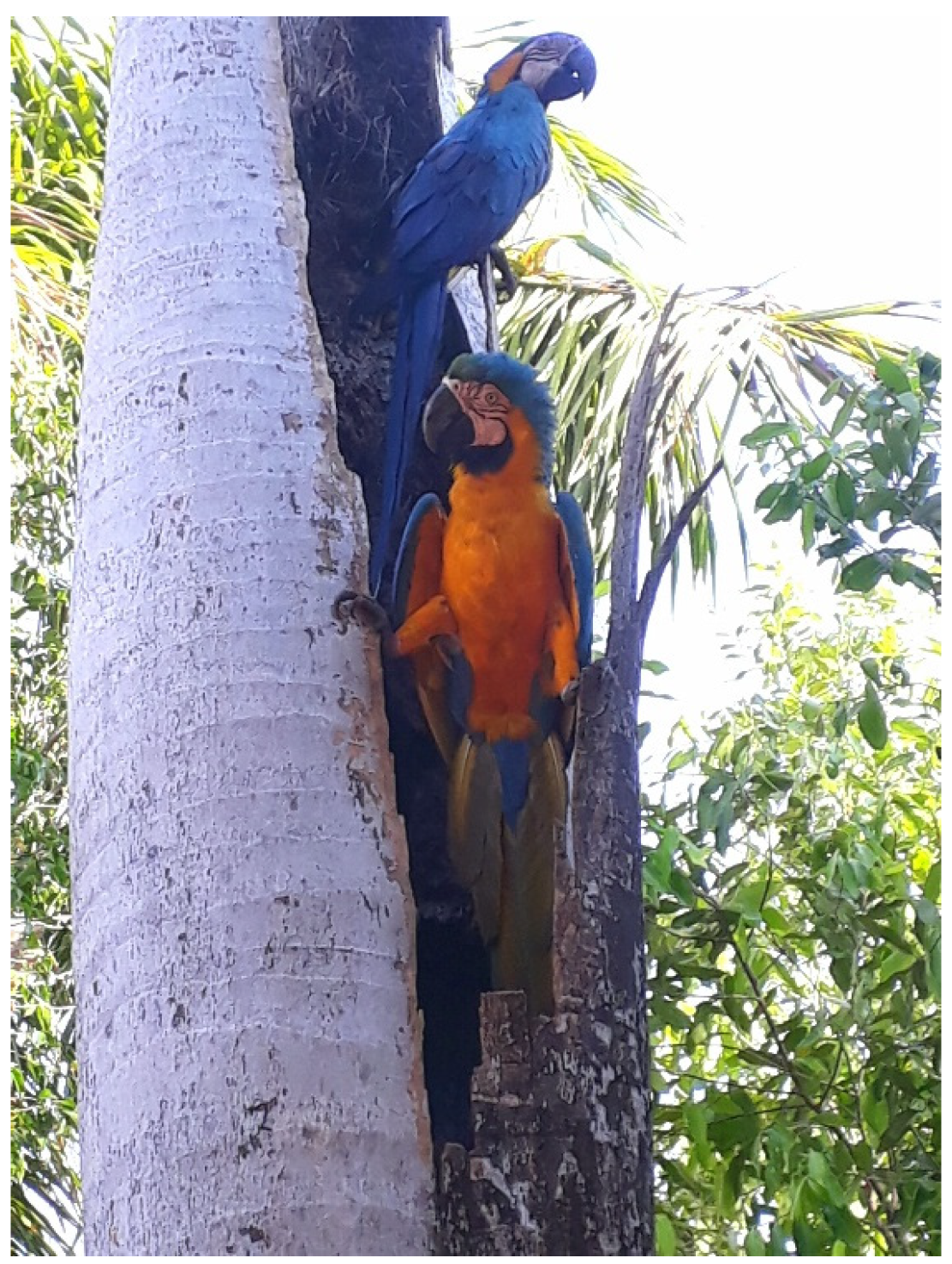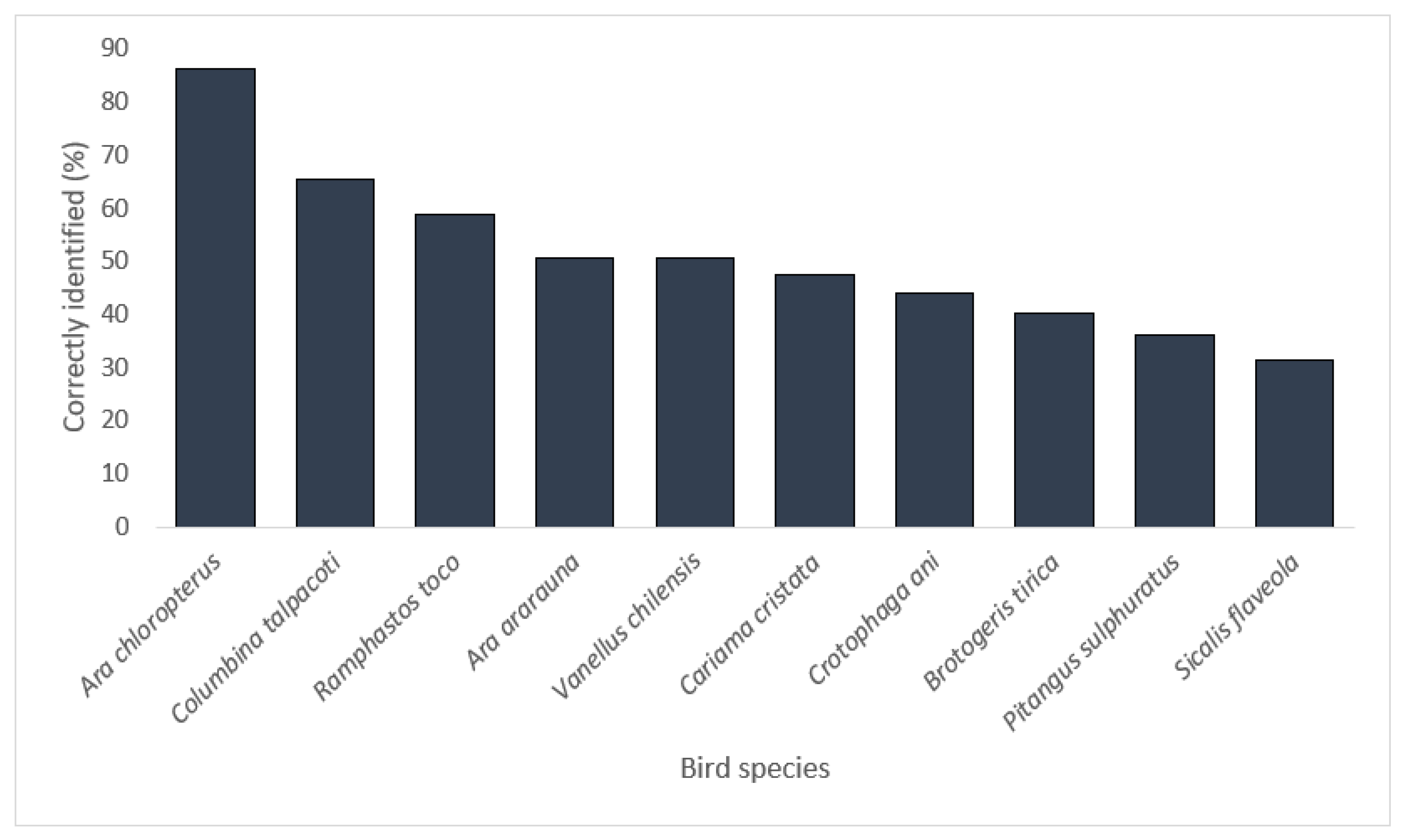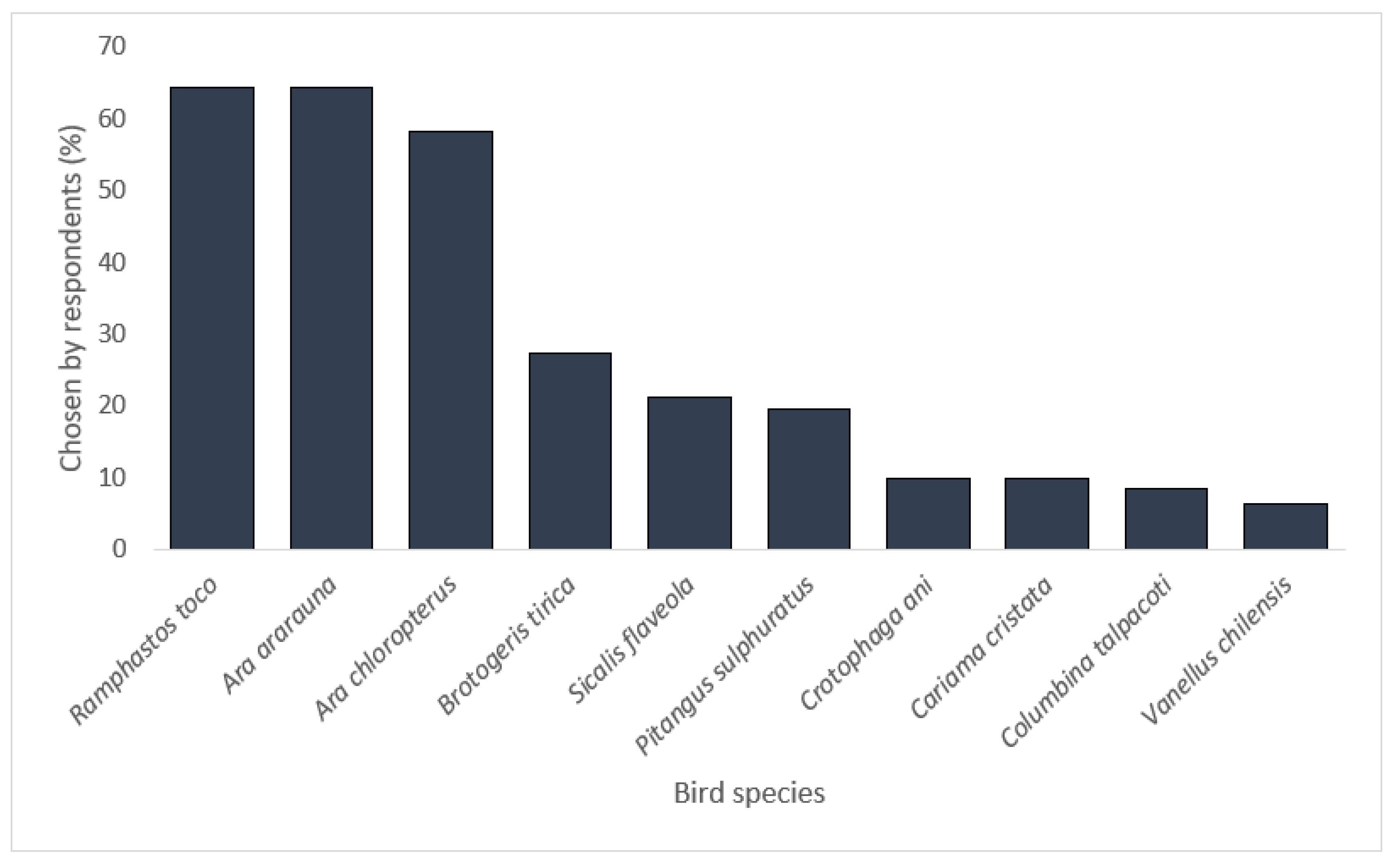Will Brazilian City Dwellers Actively Engage in Urban Conservation? A Case Study with the Charismatic Neotropical Blue-and-Yellow Macaw (Ara ararauna)
Abstract
:Simple Summary
Abstract
1. Introduction
Some, rolinha/Anda, andorinha/Te esconde, bem-te-vi/Voa, bicudo/Voa, sanhaço/Vai, juriti/Bico calado/Toma cuidado/Que o homem vem aí/O homem vem aí/O homem vem aí…
Get away, dove/Fly, swallow/Hide yourself, great kiskadee/Fly, great-billed seed finch/Fly, palm tanager/Go, grey-fronted dove/Be quiet/Be careful/‘Cause the man comes here/The man comes there/The man comes there...
(Passaredo, song by Brazilian musician and poet Chico Buarque de Hollanda, 1976: https://www.youtube.com/watch?v=y0WuNttlt8Q accessed on 8 November 2021)
2. Materials and Methods
2.1. Study Site
2.2. Collected Data
2.3. Data Analysis
3. Results
4. Discussion
5. Conclusions
Supplementary Materials
Author Contributions
Funding
Institutional Review Board Statement
Informed Consent Statement
Data Availability Statement
Acknowledgments
Conflicts of Interest
References
- Laranjeiras, T.O.; de Moura, N.G.; Vieira, L.C.G.; Angelini, R.; Carvalho, A.R. Bird communities in different phytophysiognomies of the cerrado biome. Stud. Neotrop. Fauna Environ. 2012, 47, 41–51. [Google Scholar] [CrossRef]
- Vacchiano, M.C.; Santos, J.W.; Angeoletto, F.; Silva, N.M. Do data support claims that Brazil leads the world in environmental preservation? Environ. Conserv. 2019, 46, 118–120. [Google Scholar] [CrossRef] [Green Version]
- Cunningham, C.; Beazle., K.F. Changes in human population density and protected areas in terrestrial global biodiversity hotspots, 1995–2005. Land 2018, 7, 136. [Google Scholar] [CrossRef] [Green Version]
- Strassburg, B.B.; Brooks, T.; Feltran-Barbieri, R.; Iribarrem, A.; Crouzeilles, R.; Loyola, R.; Balmford, A. Moment of truth for the Cerrado hotspot. Nat. Ecol. Evol. 2017, 1, 0099. [Google Scholar] [CrossRef] [PubMed]
- Silva, N.M.; Angeoletto, F.; Santos, W.M.C.; Filho, A.C.P.; Vacchiano, M.C.; Bohrer, J.F.C.; Candido, A.K.A.A. The negative influences of the new Brazilian forest code on the conservation of riparian forests. Eur. J. Ecol. 2017, 3, 116–122. [Google Scholar] [CrossRef] [Green Version]
- Pacheco, J.F.; Silveira, L.F.; Aleixo, A.; Agne, C.E.; Bencke, G.A.; Bravo, G.A.; De, Q.; Piacentini, V. Annotated checklist of the birds of Brazil by the Brazilian Ornithological Records Committee—Second edition. Ornithol. Res. 2021, 29, 94–105. [Google Scholar] [CrossRef]
- Oppliger, E.A.; Fontoura, F.M.; Oliveira, A.K.M.; Toledo, M.C.B.; Sliva, M.H.S.; Guedes, N.M.R. A estrutura de áreas verdes urbanas como indicador de qualidade ambiental e sua importância para a diversidade de aves na cidade de Campo Grande, Mato Grosso do Sul. Paisag. E Ambiente 2019, 30, 162864. [Google Scholar] [CrossRef]
- Santos, A.A.; Ragusa-Netto, J. Plant food resources exploited by Blue-and-yellow macaws (Ara ararauna, Linnaeus 1758) at an urban area in Central Brazil. Braz. J. Biol. 2014, 74, 429–437. [Google Scholar] [CrossRef] [Green Version]
- Carvalho-Roel, C.F.; Júnior, O.M. Assessing the relative impacts of roadkill and nest poaching on the population viability of the Blue-and-yellow macaw, Ara ararauna (Aves: Psittaciformes), in a Brazilian National Park. Diversity 2021, 13, 652. [Google Scholar] [CrossRef]
- IUCN. Red List of Threatened Species: Ara ararauna. Available online: https://www.iucnredlist.org/search?query=Ara%20ararauna&searchType=species (accessed on 1 May 2022).
- Sánchez-Mercado, A.; Ferrer-Paris, J.R.; Rodríguez, J.P.; Tella, J.L. A literature synthesis of actions to tackle illegal parrot trade. Diversity 2021, 13, 191. [Google Scholar] [CrossRef]
- Rumble, H.; Angeoletto, F.; Connop, S.; Goddard, M.A.; Nash, C. Understanding and applying ecological principles in cities. In Planning Cities with Nature; Springer: Cham, Switzerland, 2019; p. 217234. [Google Scholar]
- Luna, Á.; Romero-Vidal, P.; Hiraldo, F.; Tella, J.L. Cities may save some threatened species but not their ecological functions. PeerJ. 2018, 6, e4908. [Google Scholar] [CrossRef] [PubMed]
- Orros, M.E.; Fellowes, M.D.E. Wild bird feeding in an urban area: Intensity, economics and numbers of individuals supported. Acta Ornithol. 2015, 50, 53–68. [Google Scholar] [CrossRef] [Green Version]
- Orros, M.E.; Fellowes, M.D.E. Characterising supplementary feeding of the reintroduced Red kite (Milvus milvus) in the UK. Bird Study 2014, 61, 260–263. [Google Scholar] [CrossRef] [Green Version]
- Orros, M.E.; Fellowes, M.D.E. Widespread supplementary feeding in domestic gardens explains the return of the reintroduced Red kite Milvus milvus to an urban area. IBIS 2015, 157, 230–238. [Google Scholar] [CrossRef] [PubMed] [Green Version]
- Pranty, B.; Feinstein, D.; Lee, K. Natural history of Blue-and-yellow macaws (Ara ararauna) in Miami-Dade County, Florida. Fla. Field Nat. 2010, 38, 55–62. [Google Scholar]
- Barbosa, L.T. Fatores que influenciam o sucesso reprodutivo da arara-canindé (Ara ararauna) em Campo Grande, Mato Grosso do Sul. In Tese de Doutorado. In Proceedings of the Programa de Pósgraduação em Meio Ambiente e Desenvolvimento Regional da Universidade Anhanguera-Uniderp, Campo Grande, Brazil, 6 August 2018. [Google Scholar]
- Prefeitura Municipal de Rondonópolis/Programa de Pós-Graduação em Geografia/UFMT. Produção de Mapeamentos Temáticos para a Fase de Diagnóstico do Processo de Atualização do Plano Diretor de Rondonópolis; Relatório 03: Mapeamentos Produzidos em 1:10.000; UFMT: Rondonópolis, Brazil, 2017; 157p. Available online: http://www.rondonopolis.mt.gov.br/media/docs/plano-diretor/2017/Relatorio%20Mapeamentos%201%2010%20000.pdf (accessed on 22 August 2021).
- IBGE. Síntese de Indicadores Sociais: Uma Análise das Condições de Vida da População Brasileira; Instituto Brasileiro de Estatística e Geografia: Rio de Janeiro, Brazil, 2020. [Google Scholar]
- Leite, L.B. Flora Arbórea de Rondonópolis, Mato Grosso: Um Estudo Ecológico Urbano. Master’s Thesis, Programa de Pós-Graduação em Geografia da UFMT, Campus de Rondonópolis, Rondonópolis, Brazil, 2018. [Google Scholar]
- Santos, S.D.S.N.; Martins, C.S.G.; de Campos Martins, F. Is the knowledge about the wild birds influenced by the socioeconomic conditions of the human populations? Ethnobiol. Conserv. 2020, 9, 14. [Google Scholar]
- Thomas, R.L.; Fellowes, M.D.E. Effectiveness of mobile apps in teaching field-based identification skills. J. Biol. Educ. 2017, 51, 136–143. [Google Scholar] [CrossRef]
- Barbosa, L.T.; Calderan, A.M.P.; de Souza, C.C.; Guedes, N.M.R. Conservação da biodiversidade: Avaliação da percepção dos alunos do ensino médio. Rev. Bras. Educ. Ambient. 2019, 14, 362–376. [Google Scholar] [CrossRef]
- Calderan, A.; Tinoco, L.; Souza, C.C.; Guedes, N.M.R. Percepção dos moradores sobre as araras-canindé (Ara ararauna), na área urbana de Campo Grande (MS). Rev. Bras. Educ. Ambient. 2019, 14, 277–294. [Google Scholar] [CrossRef]
- Bizerril, M.X. Children’s perceptions of Brazilian Cerrado landscapes and biodiversity. J. Environ. Educ. 2004, 35, 47–58. [Google Scholar] [CrossRef]
- Calderan, A.; Tinoco, L.; Appel, S.; Guedes, N. A percepção dos moradores sobre a maracanã-de-cara-amarela (Orthopsittaca manilatus, Aves: Psittacidae), em área urbana de Campo Grande–MS. Braz. J. Anim. Environ. Res. 2021, 4, 2134–2145. [Google Scholar] [CrossRef]
- Freitas, C.F.S. Insurgent planning? Insights from two decades of the Right to the City in Fortaleza, Brazil. City 2019, 23, 285–305. [Google Scholar] [CrossRef]
- Kuhlmann, M. Frutos e Sementes do Cerrado Atrativos Para Fauna: Guia de campo; Rede de Sementes do Cerrado: Brasília, Brazil, 2012. [Google Scholar]
- Baños-Villalba, A.; Blanco, G.; Díaz-Luque, J.A.; Dénes, F.V.; Hiraldo, F.; Tella, J.L. Seed dispersal by macaws shapes the landscape of an Amazonian ecosystem. Sci. Rep. 2017, 7, 7373. [Google Scholar] [CrossRef] [PubMed] [Green Version]
- Angeoletto, F.; Sanz, J.P.R.; Albertin, R.M.; da Silva, F.F. The grass is always greener on the other side of the fence: The flora in urban backyards of different social classes. Ambiente Soc. 2017, 20, 1–20. [Google Scholar] [CrossRef] [Green Version]
- Silva, L.B.; Pereira, G.A.; Passos, P.B.; Almeida, N.M. Seed dispersal of the palm Acrocomia aculeata by the Blue-and-yellow macaw (Ara ararauna). Braz. J. Biol. 2021, 83, e244697. [Google Scholar] [CrossRef] [PubMed]
- Lorenzi, H. Árvores Brasileiras: Manual de Identificação e Cultivo de Plantas Árboreas Nativas do Brasil; Instituro Plantarum: Nova Odessa, Brazil, 2000; Volume 1. [Google Scholar]
- Godoi, M.N.; Laps, R.R.; Ribeiro, D.B.; Aoki, C.; de Souza, F.L. Bird species richness, composition and abundance in pastures are affected by vegetation structure and distance from natural habitats: A single tree in pastures matters. Emu-Austral Ornithol. 2018, 118, 201–211. [Google Scholar] [CrossRef]
- Mello, S.S.D.; Pastore, J.B. Ornamental flora of the Cerrado in landscape architecture: A portrait of its practical application. Ornam. Hortic. 2020, 27, 78–87. [Google Scholar] [CrossRef]
- MacGregor-Fors, I.; Juan, F.; Escobar-Ibáñez, E. Avian Ecology in Latin American Cityscapes; Springer: Berlin/Heidelberg, Germany, 2017. [Google Scholar]
- Szulkin, M.J.M.; Anne, C.E. Urban Evolutionary Biology; Oxford University Press: Oxford, UK, 2020. [Google Scholar]
- Muñoz-Pacheco, C.B.; Nelida, R.V. Avian species richness in cities: A review of the Spanish-language literature from the Southern Cone of South America. Urban Ecosyst. 2021, 25, 601–616. [Google Scholar] [CrossRef]
- Duarte, T.N.E.; Leite, L.B. Cidades Médias no Cerrado Brasileiro: Desafios para a Conservação da Biodiversidade. Terr Plur. 2019, 14, 1–7. [Google Scholar] [CrossRef]
- Santangelo, J.S.; Ness, R.W.; Cohan, B.; Fitzpatrick, C.R.; Innes, S.G.; Koch, S.; Johnson, M.T.J. Global urban environmental change drives adaptation in white clover. Science 2022, 375, 1275–1281. [Google Scholar] [CrossRef]
- Toledo, M.C.B.; Donatelli, R.J.; Batista, G.T. Relation between green spaces and bird community structure in an urban area in Southeast Brazil. Urban Ecosyst. 2012, 15, 111–131. [Google Scholar] [CrossRef]
- Curzel, F.E.; Leveau, L.M. Bird taxonomic and functional diversity in three habitats in Buenos Aires City, Argentina. Birds 2021, 2, 217–229. [Google Scholar] [CrossRef]
- Angeoletto, F.; Tryjanowski, P.; Fellowes, M.D.E. Ecology of Tropical Cities: Natural and Social Sciences Applied to the Conservation of Urban Biodiversity; Springer: Berlin/Heidelberg, Germany, 2023; accepted in press. [Google Scholar]



Publisher’s Note: MDPI stays neutral with regard to jurisdictional claims in published maps and institutional affiliations. |
© 2022 by the authors. Licensee MDPI, Basel, Switzerland. This article is an open access article distributed under the terms and conditions of the Creative Commons Attribution (CC BY) license (https://creativecommons.org/licenses/by/4.0/).
Share and Cite
Angeoletto, F.; Tryjanowski, P.; Santos, J.; Martinez-Miranzo, B.; Leandro, D.; Bohrer, J.; Johann, J.M.; Fellowes, M.D.E. Will Brazilian City Dwellers Actively Engage in Urban Conservation? A Case Study with the Charismatic Neotropical Blue-and-Yellow Macaw (Ara ararauna). Birds 2022, 3, 234-244. https://doi.org/10.3390/birds3020015
Angeoletto F, Tryjanowski P, Santos J, Martinez-Miranzo B, Leandro D, Bohrer J, Johann JM, Fellowes MDE. Will Brazilian City Dwellers Actively Engage in Urban Conservation? A Case Study with the Charismatic Neotropical Blue-and-Yellow Macaw (Ara ararauna). Birds. 2022; 3(2):234-244. https://doi.org/10.3390/birds3020015
Chicago/Turabian StyleAngeoletto, Fabio, Piotr Tryjanowski, Jeater Santos, Beatriz Martinez-Miranzo, Deleon Leandro, João Bohrer, Juciane Maria Johann, and Mark D. E. Fellowes. 2022. "Will Brazilian City Dwellers Actively Engage in Urban Conservation? A Case Study with the Charismatic Neotropical Blue-and-Yellow Macaw (Ara ararauna)" Birds 3, no. 2: 234-244. https://doi.org/10.3390/birds3020015
APA StyleAngeoletto, F., Tryjanowski, P., Santos, J., Martinez-Miranzo, B., Leandro, D., Bohrer, J., Johann, J. M., & Fellowes, M. D. E. (2022). Will Brazilian City Dwellers Actively Engage in Urban Conservation? A Case Study with the Charismatic Neotropical Blue-and-Yellow Macaw (Ara ararauna). Birds, 3(2), 234-244. https://doi.org/10.3390/birds3020015








